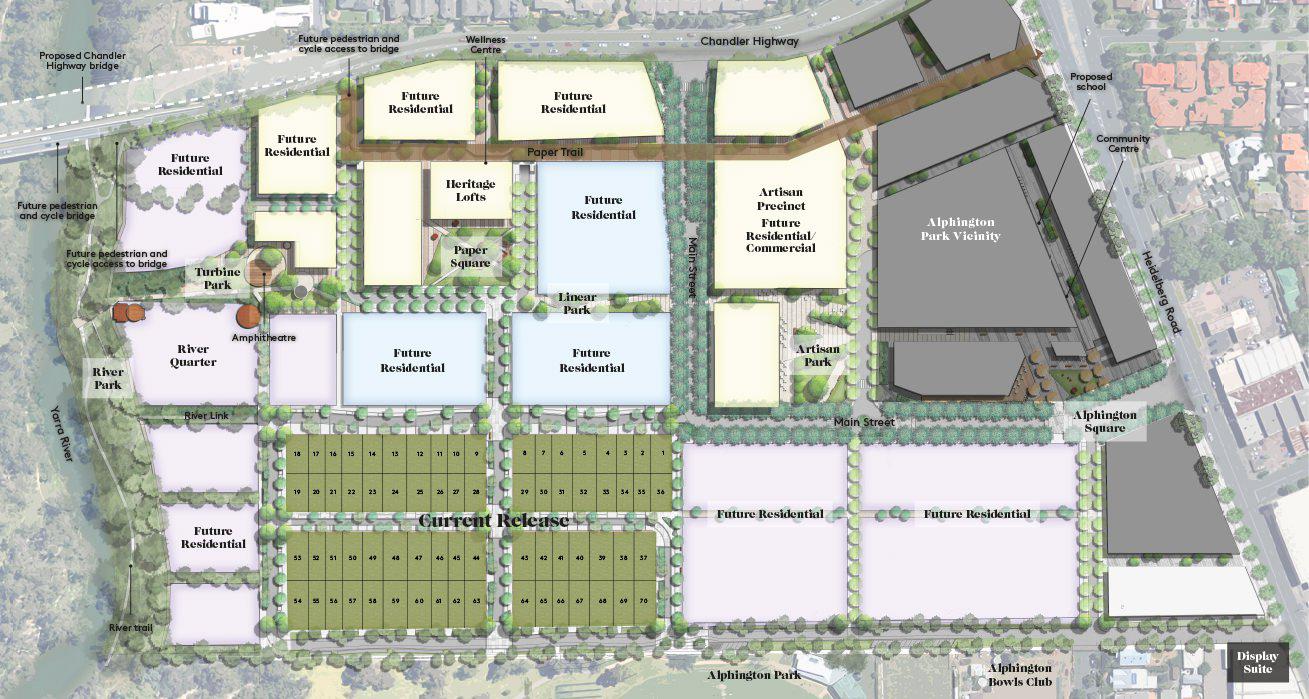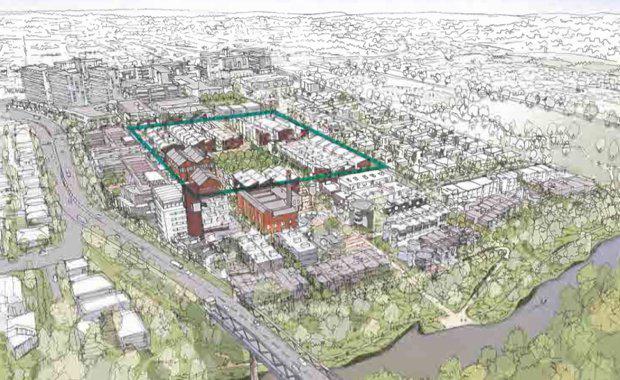YarraBend Breakdown: A Play-By-Play Of The Alphington Paper Mill Development Site
TUD+ MEMBER CONTENT-This article has been updated to reflect newer and more accurate information.
Developed by Glenvill, ‘Yarrabend’ occupies the former Amcor Paper Mill site in Alphington, which is within the City of Yarra on a 16.5 hectare parcel of land located on the corner of Heidelberg Road and the Chandler Highway, extending down to the Yarra River.
It is the newest suburb to hit Melbourne’s surrounding areas.
It was acquired after Amcor stopped paper recycling operations at the site in late 2012.

Yarrabend is expected to provide all of the elements a solid suburb should, like retail offerings, a specialty retail hub, apartments, townhouses and traditional house blocks. Yarrabend will also benefit from a proposed new shopping centre and community facilities delivered by others on the broader Paper Mill site.
The final Development Plan for the Paper Mill site was approved unanimously by Councillors in December 2015, and Glenvill has subsequently received planning permits for the first stages of the 'Yarrabend' development on the eastern portion of the site.

YarraBend will feature architecturally designed free hold homes, town houses and apartments. It has been meticulously master planned to include amenities such as an exclusive wellness centre, home to a 25m heated indoor swimming pool, yoga exercise areas, steam and sauna rooms, and a large state-of-the-art gym. Food industry specialists will curate a 2,000m2 cosmopolitan hospitality precinct within YarraBend, creating an exciting new dining experience.
As a smart-wired suburb, YarraBend residents will enjoy the efficiency of high speed internet, and the YarraBend Tech Concierge service will be available to assist with everything from home entertainment set-up to technical support, allowing residents to move into their new home or update technology with ease.
Related article: Yarrabend: The World’s First Tesla-Powered Town

Glenvill has committed to a range of initiatives to enhance environmental sustainability at YarraBend, including the approach to horticultural design, water storage, community gardens and green rooftops. This future-focussed suburb will achieve the highest possible ESD rating under the UDIA EnviroDevelopment scheme, a first for an infill development site in Melbourne.
A lot of news has circulated around Yarrabend activity, from architect appointments to housing offerings, but what more do we know about the future suburb’s moving parts?

A breakdown of the Alphington Paper Mill development’s 'Yarrabend'
Glenvill and its consortium partner Alpha Partners have cultivated a vision for the development of a mixed use village and residential community on a large inner-city infill site. It is divided into seven ‘precincts’ that provide diverse development outcomes and a distinct individual character:
Precinct 1— Gateway Precinct
Precinct 2 — Village Precinct
Precinct 3 — Artisan Precinct
Precinct 4 — Park Precinct
Precinct 5 — Workshops Precinct
Precinct 6— Outer Circle Precinct
Precinct 7 — Heritage and Riverfront Precinct
Related article: Alphington Proposed Site For New Mixed-Use Vertical Forest

Gateway Precinct
The Gateway Precinct plays an important role in contributing to the diverse housing needs of the community. The focus in this precinct on residential uses with supporting showroom and retail opportunities creates a location for interaction and activity at the entry to the site. The sensitively designed new built forms will ensure integration into the local character of the area.

The Gateway Precinct will predominately contain residential uses with a smaller proportion of non- residential areas including potential for community, educational, employment, retail and commercial activities. The concentration of uses can support a range of higher density housing options integrated into the precinct.
The scale of the precinct, its context and the mix of the intended uses support the provision of larger building footprints, with publicly accessible open spaces that will help distinguish the public interfaces from more private uses.
The development plan acknowledged the existing Paper Mill buildings along Heidelberg Road having made a dominant contribution to the site in the past, guiding the precinct character and historical themes.
Village Precinct
The Village Precinct will contain a significant proportion of non-residential uses including community, employment and retail activities, however will also provide a range of higher density housing options.

The precinct’s main focus will be centred towards providing supermarkets, specialty retail and hospitality opportunities, with multi-storey buildings that will be used for recreational facilities and commercial uses including medical services, commercial office space and studio offices.
A minimum of 1700m2 of floor space for community facilities is proposed within the precinct, with a potential for extension into education and childcare, offering primary education and early learning centres.
Delivered by Alpha Partners, the Village Precinct will be the heart of retail, commercial employment and community activity for Alphington. It will act as an activity anchor for the whole development area and service the needs of existing residents in the wider Alphington catchment.
Artisan Precinct
The Artisan precinct will comprise a mix of residential and non-residential uses, with retail options primarily found at ground level with residential uses above. This precinct will providing a sense of "shop-top and live/work" types of urban development.

Providing a transition between the scale and intensity of the Village Precinct and the residential focus of the Workshops Precinct, the Artisan Precinct will provide opportunities for medium and higher density built form, anchored by a 2,000 square metre publicly accessible open space.
The precinct’s buildings will be built at a relatively low overall height to provide a transition in density between the Village Precinct to the north and Workshop Precinct to the south.
Park Precinct
The Park Precinct will be a part of Yarrabend with a more residential focus. Glenvill's development plan said there will be opportunities for live/work or integrated home office and retail along the northern and western edges of its sub precincts.

"The Park Precinct responds to the original function of the eastern half of the site as a residential subdivision," the development plan said.
"It is heavily influenced by its proximity to the parklands to the east and the scale and leafy character of residential streets throughout Alphington.
The precinct transitions from a more urban character in the north adjacent to the Alphington Gateway Precinct, to a more low-rise area with buildings embedded in landscape towards the Riverfront Precinct to the south."
The Park Precinct will provide an opportunity for medium density urban built form integrated with lower density detached housing allotments, encouraging courtyards and backyards with landscape zones in deeper lower density blocks.
Workshops Precinct
Like the Park Precinct, the Workshops Precinct will be predominantly utilised for residential uses, generally between three to four storeys, with some potential for commercial, retail and community program facing Main Street.

The Workshop Precinct's main selling point is it homage to the area's heritage. Referencing the industrial history of the site, the precinct will include a fine grain laneway street network and the use of materials like brick along the east-west roads.
Glenvill said they plan to reuse and adapt the precinct's larger existing industrial buildings for housing, and reuse existing masonry walls, roof trusses, metal piping and storage tanks to link to the site's past.
Outer Circle Precinct
The Outer Circle Precinct will contain long buildings acting as a built form edge to Chandler Highway protecting a pedestrian link called the Paper Trail, which connects the Artisan Precinct to the Heritage Precinct through a continuous linear park.

The precinct is to be predominately residential with some scope for work/live uses along the Paper Trail public space, with multiple pedestrian connections to adjacent residential buildings and the surrounding streets.
According to the development plan, the continuous built form abutting the western edge of the Paper Trail should be masonry construction to recall the former industrial buildings that once flanked the western edge of the transport corridor. Upper levels will be made from materials with a lighter appearance and be highly glazed.
Riverfront Precinct
The Riverfront Precinct has almost 300m of direct frontage to the Yarra River and will be designed to prioritise a sensitive response to the existing river corridor. The mix of dwellings in this precinct includes 2-3 storey townhouses and low rise apartment opportunities.

According to the development plan, both zones that make up the Riverfront Precinct have significant heritage value, and as a result will be a highly invested public realm which could include in-built street furniture and re-use of existing heritage water infrastructure integrated into the landscape response.
The precinct has been strongly influenced by the presence of both the 1920 and 1954 boiler houses as well as significant water related infrastructure, such as the River Pump House and the large water storage tanks which will be retained and used for unique townhouse conversions.
"The presence of the rail bridge also adds to the transport character of the site. All these elements provide a rich context for thematic interpretation in both the public realm and built form."
Yarrabend's final development plan was the result of two rounds of formal community consultation, over 12 months, with a total of 365 written submissions and many verbal presentations to the City of Yarra.
Images courtesy Glenvill. Precinct artist impressions courtesy Glenvill's Alphington Paper Mill Development Plan, City of Yarra.













